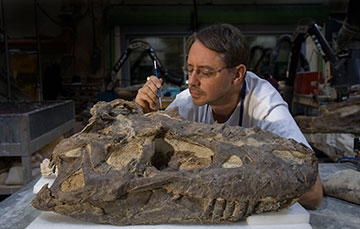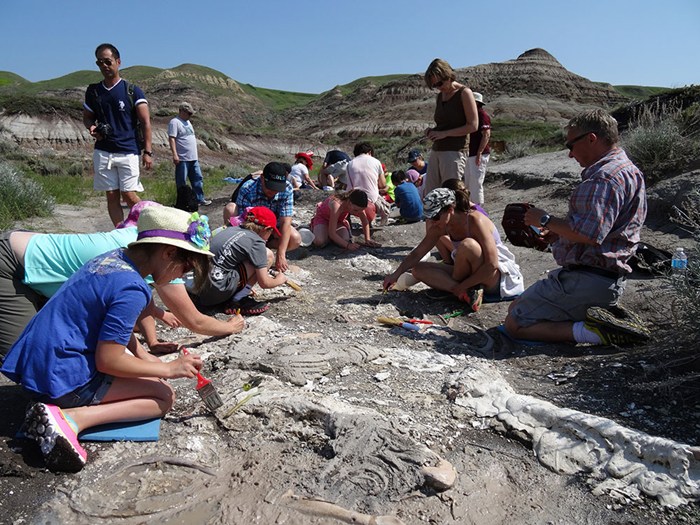DRUMHELLER, AB - We’re en route to this “western gateway to the badlands” on a mission to delve into the world of dinosaurs.
Drumheller is about a two-hour drive northeast of Calgary, along a straight ribbon-road through prairie that seems to stretch forever with nothing but green fields dotted sporadically with cows, llamas and oil-pumping iron horses. Thankfully, we’ve got a full tank of gas, because service centres are noticeably absent from this countryside.
Just when we think there is no end to the flat green, we abruptly plunge 100 metres down into a coulee (corridor) and find ourselves in an eerie, sand-coloured moonscape surrounded by weird rock outcrops.
This is the carved-out badlands of Red Deer River Valley.
“It’s like we’re driving beneath Alberta rather than through it,” comments 18-year-old Claire, one of two teenaged grandchildren (and their parents) who are along with my husband and I on this family dinosaur hunt.


Left: The largest dinosaurs roamed the Bad lands of Alberta long before humans arrived. Right: Scientists study the bones unearthed in Drumheller, which is where the world
Our first foray is to check out a cluster of hoodoos along the Hoodoo Trail, between Drumheller and East Coulee. Each of these misshapen, ochre pillars is composed of soft sandstone, topped with a resilient cap that slows the erosion of the softer rock underneath. Each has a unique shape.
“They look like giant petrified mushrooms,” says 14-year old Emma, as we hike amid them and up the surrounding hillside.
It’s easy to understand why Native People believed these sculpted rocks were giants, turned to stone by the Great Spirit because of their evil deeds. Information plaques along the trail tell us that “a hoodoo wears down on average three millimetres per year, adding up to a colossal 80,000 tonnes of eroded sand, salt and clay every year.”
We want to get down, dirty and dig, so we head for Dinosaur Provincial Park, a two-hour drive south of Drumheller, at the northern limit of the Great Plains. The Park, named a UNESCO World Heritage Site in 1979, is home to the world’s largest concentration of dinosaur fossils from the late Cretaceous era.
Some 75 million years ago, the valley’s semi-tropical climate and lush vegetation provided ideal living conditions for the dinosaurs. But 10 million years later, the climate changed drastically, wiping out the creatures, whose bones settled on the river bed where they were covered by sandstone and mud, and over time becoming fossilized.
In 1884, J.B. Tyrrell came looking for coal deposits and stumbled across a pile of very large bones, sparking the “great Canadian dinosaur rush.” Paleontologists from around the world came in search of skeletons and, over the past century, excavated more than 300 of them (including 150 complete skeletons) which are on display in museums worldwide. More are still being found.


Left: Families love taking part in dino digs. Right: The Alberta Bad lands are worth the drive on their own.
This is where we hoped to join a real dinosaur dig, but as (bad) luck would have it, it pours rain and the dig is cancelled for safety reasons. We have to content ourselves with touring the museum to learn more about these enormous beasts, and the lifestyle of the early dinosaur explorers.
There’s even more to learn at the world-renowned Royal Tyrrell Museum of Paleontology in Drumheller, which is nothing like some of the dreary museums I recall visiting on school trips. The Tyrrell, which gets about 400,000 visitors a year, is a rich hands-on experience for all ages. There are 40 complete dinosaur skeletons on display, including a colossal tyrannosaurus rex and an amazing mosasaur marine reptile with an exquisitely-preserved metre-long fish in its stomach.
Experiencing their mighty presence is like stepping into a real Jurassic Park and becoming dinosaur-crazed kids again.